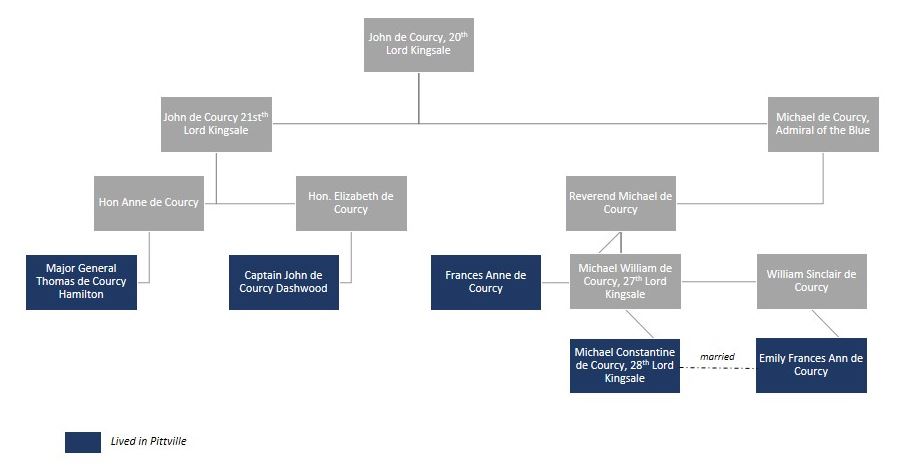
On 23 May 1839 a grand wedding took place at St Mary’s, Cheltenham (now Cheltenham Minster). The couple getting married were Captain John de Courcy Dashwood RN and Henrietta Willoughby Barrett who, between them, represented and enjoyed all the privileges of wealthy early Victorian society. After the wedding, they settled in Pittville, where Henrietta was already living.
The marriage was witnessed by John’s father, Vice-Admiral Sir Charles Dashwood KCB and Henrietta’s stepfather, Laurence Oliphant, 8th Laird of Condie and 30th Chief of Clan Oliphant.
Not present was Henrietta’s father, Samuel Barrett, who had died in 1824 at the age of 35, when she was only 9 years old. Samuel – known as “Handsome Sam” – was a member of the extremely wealthy Barrett family of Jamaica, a dynasty of plantation owners who, between them, owned thousands of slaves and were influential in the development of the colony.

Henrietta’s mother, Margaret Gilles Storey, was also absent, having died in 1828. Margaret’s father, Robert Storey made his fortune in India, where he took part in the Battle of Arcot under Robert Clive and became the Physician to the Nabob of Arcot, Tamil Nadu.
We do not know if John Dashwood’s mother, the Honourable Elizabeth de Courcy, daughter of Lord Kingsale of County Cork, was present. What is without doubt is that the joining of the Dashwoods and Barretts brought together all the key elements underpinning British wealth and global supremacy during the early 19th century – naval dominance, colonial exploitation, and titled peerages.
Before turning to John and Henrietta Dashwood’s married life in Pittville, let’s take a look at their family backgrounds in more detail.

John Dashwood was born in Plymouth, Devon, to a naval family. He was the middle of three brothers, all born in Plymouth – Charles Robert in 1801, John de Courcy in 1802, and Francis in 1805.
Their father was Vice-Admiral Sir Charles Dashwood KCB, a distinguished British officer, who served in the Royal Navy during the American Revolutionary War, the French Revolutionary Wars, the Napoleonic Wars, and the War of 1812.
Their mother was the Honourable Elizabeth de Courcy, the daughter of Lord Kingsale of County Cork. John was named after his grandfather John de Courcy, the 21st Baron Kingsale of Kinsale, who was born in Rhode Island in the United States and came to Ireland as a child when his father succeeded to the title.
Charles and Elizabeth were married in November 1799, at St Andrew’s, a parish in Plymouth.
John and his brothers grew up in the busy naval port of Plymouth in the height of the Napoleonic wars. Their father was at sea most of the time, holding the command of HMS Franchise between 1805 and 1810 and taking part in many famous naval battles. It is hardly surprising that the two eldest sons followed his footsteps – both joining the navy at the tender age of 12. The only consolation was that they both started their service under their father’s command.
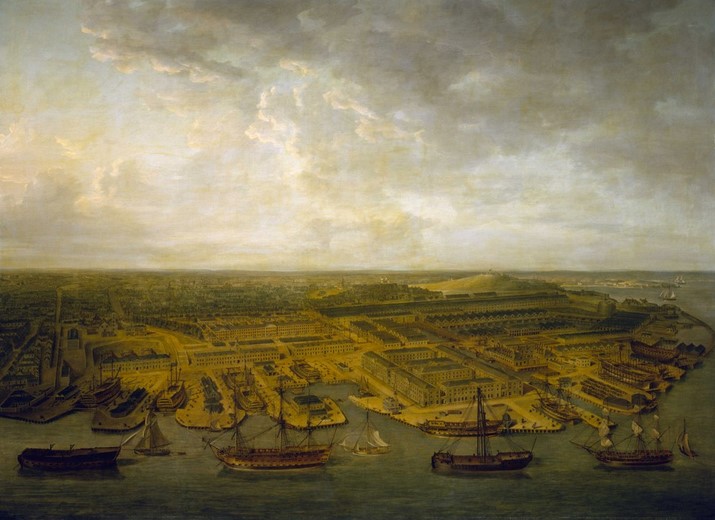
Plymouth Dockyard in 1798 (painting by Nicholas Pocock): Wikipedia, public domain
 John entered the Navy on 23 August 1814 as a Midshipman on board HMS Norge, commanded by his father. He soon saw action as the Norge was one of the fleet of sixty British ships which supported the Battle of New Orleans in late 1814/early 1815.
John entered the Navy on 23 August 1814 as a Midshipman on board HMS Norge, commanded by his father. He soon saw action as the Norge was one of the fleet of sixty British ships which supported the Battle of New Orleans in late 1814/early 1815.
John then spent two years at the Royal Naval College. He was awarded the first mathematical prize on graduating in June 1818.
He then re-embarked on board HMS Phaeton under Captain William Henry Dillon. Ancestry: (credit) JeremyWhite53
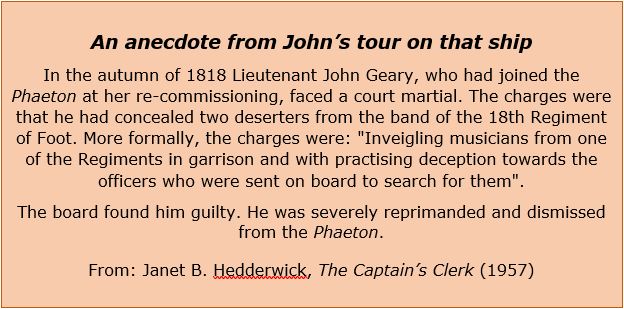
 As well as two attachments to the Phaeton under Captain Dillon and William Augustus Montagu, John also sailed for the West Indies in HMS Liffey under Captain the Hon. Henry Duncan.
As well as two attachments to the Phaeton under Captain Dillon and William Augustus Montagu, John also sailed for the West Indies in HMS Liffey under Captain the Hon. Henry Duncan.
On 24 September 1822 he re-joined his father as Admiralty Midshipman on board HMS Windsor Castle and attained the rank of Lieutenant on 1 January 1824. His brother Charles was also attached to the ship and in April 1824 all three of the Dashwoods were involved in a curious incident with the King of Portugal, João VI, in which his son, Prince Miguel, attempted a coup by raising the Lisbon garrison and confining his father to the Bemposta Palace. But the King outsmarted his son: he pretended to be going out for a ride with his escorts, the British and French ambassadors, and boarded HMS Windsor Castle, from where he summoned his son and informed him that he was relieved of the command of the Army and would be sent into exile in Austria (Barry Hatton, Queen of the Sea: 2018, p. 190). [Medal image credit: National Army Museum]
As a result of their involvement in this ruse, all three of the Dashwoods, along with other officers of the Windsor Castle, received Portuguese knighthoods in March 1825.
John’s final ship was HMS Dryad, employed on the Channel, Cork and Mediterranean stations. He was placed on half pay in 1829 and did not sail again. He was promoted a Commander in 1834.
The source for all naval information in this section: William Richard O’Byrne A Naval Biographical Dictionary.



Henrietta Barrett was born in 1815 at Park Hill, Doncaster, the only daughter of Samuel (“Handsome Sam”) Barrett. Her family’s story is a fascinating one.
Handsome Sam was born 1788 at Spring Estate, St James, Jamaica into a wealthy sugar-planting, slave-owning family. His grandfather Edward Barrett became one of Jamaica’s wealthiest and most influential planters. Their wealth was heavily dependent on the slave trade and the Barrett family owned over 2,000 slaves (source: jamaicagreathouses.com)
Edward Barrett built Cinnamon Hill in 1734, one of the great houses of Jamaica, which for 40 years later became the home of the singer Johnny Cash.

Cinnamon Hill today Edward and his wife Judith Goodin had one daughter, Elizabeth, and two sons, George and Samuel.
Their son George had six children with Elisa Peters, one of his father’s slaves. George died in 1795, aged 35, and the children were sent to live with John Graham Clarke in Newcastle-upon-Tyne (see box below), as he specified that they should ‘not fix their abode in Jamaica but do settle and reside in such countries where those distinctions respecting colour are not maintained’. His will left £2,000 each to his six children and freed Elisa Peters, lately conveyed to him by his father Edward, and left her an annuity of £50 a year.

Meanwhile Samuel was raised and educated in London, and became a Captain in the 1st Troop of Horse Grenadier Guards, before returning to Jamaica and becoming a member of the Assembly (source: www.barrettfamilyhistory.wordpress.com). Samuel had four illegitimate sons – including Handsome Sam – with a widow, Elizabeth Barrett Williams, who was his first cousin, before dying in Spanish Town of “putrid fever” at the age of 29.

‘Pinkie’, by Sir Thomas Lawrence (1794): Wikipedia Having outlived both his sons and as a result of the illegitimacy of his sons’ children, Edward persuaded his daughter Elizabeth’s children to change their name formally from Moulton to Barrett, and they duly inherited the bulk of the Barrett family wealth. Handsome Sam’s cousin, Edward Moulton Barrett, was the father of Elizabeth Barrett Browning the poet – thus making her second cousin to Henrietta. Elizabeth’s mother, Mary, was the daughter of John Graham Clarke.
Another of Handsome Sam’s cousins was Sarah Goodin-Moulton, known as ‘Pinkie’. She was the subject of the well-known portrait by Sir Thomas Lawrence, painted in 1794, a year before her death at the age of 12.
As an adult, Handsome Sam inherited his Uncle George’s Spring Estate and Thatchfield Pen – along with over 500 slaves – and he acquired a third plantation, Schawfield, in 1815. He benefited from these as an absentee landlord until his death in 1824. (source: UCL)
During this period Handsome Sam lived in England and in 1812 married Margaret Gilles Storey:
“MARRIED – October 7th inst. At Cramlington, in the county of Northumberland, by the Rev. Richard Butler, Samual Barrett, Esq. of the Island of Jamaica, to Margaret Gilles Storey, daughter and co-heiress of Robert Storey, Esq. of Arcot, in the said county. (Morning Post 17 March 1812)”


The family moved to Park Hill, a home leased from A. B St Leger (whose uncle founded the St. Leger stakes), in Firbeck, Doncaster. Their son – also Samuel Goodin Barrett – and daughter Henrietta were both born there. The home was shared with Handsome Sam’s half-brother Martin Williams and his family – from his mother’s previous husband.
It is not known exactly when the family moved to Cheltenham or where they lived when they arrived here. From codicils attached to Handsome Sam’s will we find him at Ham Common, Surrey in 1818, in Bologne, France in 1823, and in Cheltenham in 1824. Handsome Sam died in Cheltenham in 1824 at the age of 35 “after a lingering illness borne with the greatest fortitude and resignation” and was buried in Holy Trinity Church on Winchcombe Street on 20 June.

Memorial tablet to Samuel Barrett,
in Trinity Church, Portland Street, Cheltenham 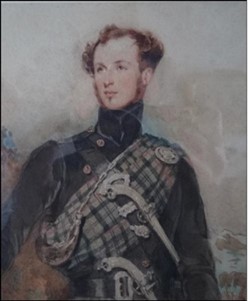
Samuel Goodin Barrett (1812-76)
source:www.doncasterhistory.wordpress.com Henrietta’s mother did not mourn for long, and the following year she married Laurence Oliphant, 8th Laird of Condie and 30th Chief of Clan Oliphant – who had been the executor of Handsome Sam’s will. They moved to the Oliphant family seat, Newton of Condie in Perthshire. Margaret died in 1828. (source: UCL)
It is not known what happened to Henrietta between 1828 and 1839, and there is no record of her ever going to Jamaica, but her brother Samuel Goodin Barrett, a Captain in the Perthshire Militia and known as “Long Sam”, as well as inheriting interests there from their father, was also a beneficiary of his uncle, Richard Barrett, whose only child had died.
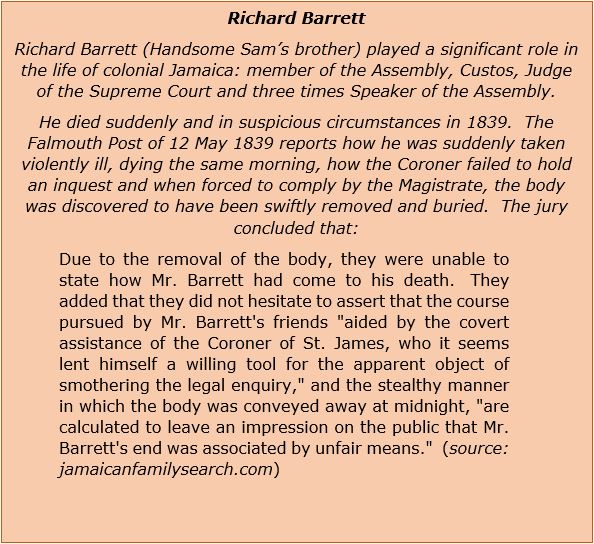
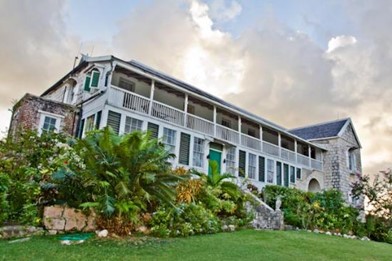
Greenwood, Montego Bay, Jamaica
Long Sam moved to Jamaica with his family and is recorded as entertaining the visiting Governor of Jamaica on 4 March 1840. According to the Falmouth Post: “His Excellency accompanied by his secretary proceeded to Greenwood, the elegant mansion of S. G. Barrett, Esq. In the evening Mr. Barrett gave a princely entertainment to a select party, and on Friday morning His Excellency repaired to the town of Falmouth where he arrived soon after eleven o’clock in Mr. Barrett’s carriage drawn by four beautiful and spirited horses.” (source: www.jamaicanfamilysearch.com)
Another Elizabeth Barrett Browning connection here: when Samuel and his wife Maria left England for Jamaica, Maria left Elizabeth Wilson, who was in her service, to become a personal lady’s maid to Elizabeth Barrett Browning; she signed the register at Elizabeth and Robert’s marriage and in 1846 went with them to Italy. (source:doncasterhistory.wordpress.com)
Ten days after Richard Barrett’s mysterious death in Montego Bay, Henrietta married John Dashwood at St Mary’s, Cheltenham Minster. Whether or not Long Sam’s inheritance and Henrietta’s marriage happening in the same month was purely coincidence, or something more, we will never know.






in Trinity Church, Portland Street, Cheltenham

source:www.doncasterhistory.wordpress.com


Greenwood, Montego Bay, Jamaica

Henrietta Barrett’s address is shown as Pittville Lawn at the time of her marriage; perhaps she had been staying with her aunt Barrett Lee at 39 Pittville Lawn (see the Pittville History Works article “Pittville and the Inheritance of the Slave Trade”). We know the family were closely connected, as brother Long Sam is recorded in Barrett Lee’s home in the 1871 census. Barrett Lee, born Williams, was the legitimate daughter of Handsome Sam’s widowed mother, Elizabeth and hence they were half-siblings. Only three years apart in age, research suggests that the legitimate Williams and illegitimate Barretts grew up together in Spring Estate, Jamaica.
Her husband John Dashwood’s address is shown as Montpellier Spa Buildings, suggesting that he was not a resident before his marriage. How the couple came to meet and settle in Pittville is not known.
After marrying, the Dashwoods settled into life in Pittville, living at many different addresses and also spending time in Torquay, once a naval stronghold but now newly fashionable, and also London. Their homes always had three or four servants, including from 1851 until Henrietta’s death, a Maria Godwin from Devon.

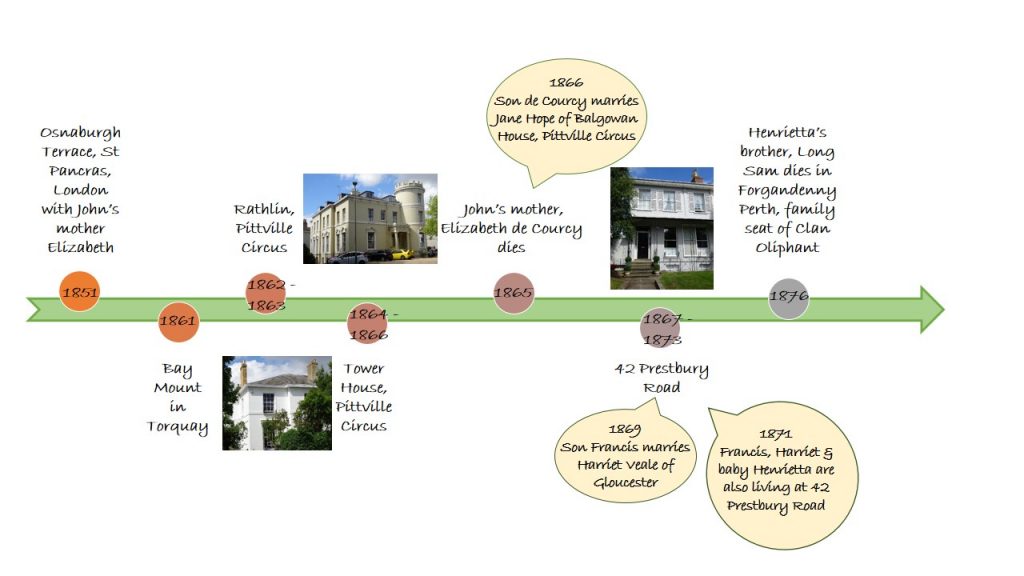
John de Courcy Dashwood died on 29 July 1878, aged 76, the day on which Francis and Harriet’s twins were baptised and only seven months after the death of his brother Charles. His address at death is given as 3 Trinity Terrace, Cheltenham (just north of Trinity Church on Portland Street), which was Francis and Harriet’s home. He was buried in Cheltenham Cemetery on 2 August.
Following John’s death Henrietta moved in with son Francis and family and is recorded with them at 15 Oxford Park, Ilfracombe, Devon, in the 1881 census. Henrietta died in Ilfracombe in 1883.



